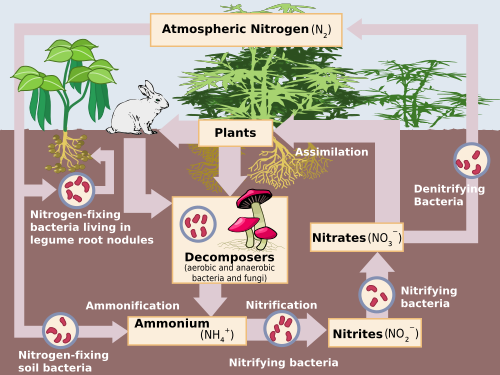Nitrogen cycle
- Topic in Gardening courses
- See also Nitrogen
The diagram to the right shows how nitrogen gas that is present in the atmosphere goes into a cycle that makes nitrogen available to plants.
- Nitrogen from the air is fixed by bacteria that live as nodules on roots of legumes[1] and some other plant species. These nitrogen-fixing bacteria give nitrogen to the plants on which they live, and when these plants die, the nitrogen remains in the soil.
- Nitrogen from the air is fixed by nitrogen-fixing soil bacteria. They transform nitrogen to ammonium (NH4+). This process is called ammonification[2].
- Animals drop manure into the soil. Animals and plants die and animal waste and dead animals and plants are decomposed by aerobic and anaerobic fungi and bacteria. Also through this process, ammonium (NH4+) is formed.
- Nitrifying bacteria transform ammonium (NH4+) first into nitrites (NO2-) and then into nitrates (NO3-) in a process called nitrification[3].
- Plants can assimilate nitrates (NO3-). Nitrates are also affected by denitrifying bacteria that bring nitrogen gas back into the atmosphere in a process called denitrification[4].
Some practical implications
Plants need nitrogen for their growth. A main component of fertilizers is nitrogen in a form that plants can take in. One way to improve your soil is by adding compost that is rich in nitrogen. Another method is to grow legumes (for example peas and beans, and a few other plant species, not legumes) that form root nodules with nitrogen-fixing bacteria. Yet another method is to sow fast growing plants only for the improvement of your soil. These plants are called 'green manure' plants. Some examples of green manure plants are phacelia, rye and mustard but there are many more. Yet another method is to cover the soil with a layer of decomposing plants, in the form of hay or straw or material of any other plants. This method is called mulching. These plants decompose and enrich the soil with humus-forming components and also with nitrogen.
To enable a speedy process of ammonification and nitrification in your soil, your soil should not only be rich of compost or decomposing plant materials, but should also contain enough oxygen, as most micro-organisms and also animals such as rain worms that decompose these materials need oxygen. By bringing more oxygen into the soil you can also prevent denitrification to take place as denitrifying bacteria operate when there is not enough oxygen in the soil.
Oxygen can be brought into the soil in various ways. First by ploughing or cultivating a field. Second by adding enough organic material, in the form of mulch or compost or decomposed animal manure. Third by planting green manure plants and also plants that have deep roots. When these plants die, their roots leave channels in the soil where air with oxygen can penetrate.
See also
- Balance of nature
- Gardening courses
- Knowledge base:Gardening
- Micro-organisms in the soil
- Some science for the gardener, section Nitrogen cycle
References
- ↑ Legumes - Wikipedia "A legume is a plant in the family Fabaceae (or Leguminosae), or a fruit of these specific plants."
- ↑ Ammonification - Wikipedia "When a plant or animal dies, or an animal expels waste, the initial form of nitrogen is organic. Bacteria, or fungi in some cases, convert the organic nitrogen within the remains back into ammonium (NH4+), a process called ammonification or mineralization."
- ↑ Nitrification - Wikipedia "Nitrification is the biological oxidation of ammonia with oxygen into nitrite followed by the oxidation of these nitrites into nitrates."
- ↑ Denitrification - Wikipedia "Denitrification is a microbially facilitated process of nitrate reduction that may ultimately produce molecular nitrogen (N2) through a series of intermediate gaseous nitrogen oxide products."
External links
- Denitrification "Denitrification is a microbially facilitated process of nitrate reduction that may ultimately produce molecular nitrogen (N2) through a series of intermediate gaseous nitrogen oxide products." - Wikipedia
- Nitrification "Nitrification is the biological oxidation of ammonia with oxygen into nitrite followed by the oxidation of these nitrites into nitrates. Degradation of ammonia to nitrite is usually the rate limiting step of nitrification. Nitrification is an important step in the nitrogen cycle in soil." - Wikipedia
- Nitrogen cycle "The nitrogen cycle is the process by which nitrogen is converted between its various chemical forms. This transformation can be carried out via both biological and non-biological processes. Important processes in the nitrogen cycle include fixation, mineralization, nitrification, and denitrification." - Wikipedia
- Nitrogen cycle Research Topics
- Nitrogen fixation "Nitrogen fixation is the natural process, either biological or abiotic, by which nitrogen (N2) in the atmosphere is converted into ammonia (NH3)." - Wikipedia
- Organic Materials as Nitrogen Fertilizers "Organic materials usually are added to soils to provide such plant nutrients as nitrogen and to improve the physical nature of the soil." - Colorado State University

